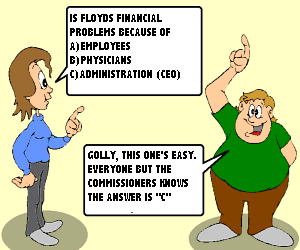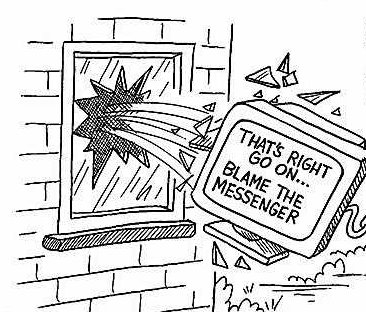Tuesday, October 31, 2006
Monday, October 30, 2006
Forum is now open
Well I am fairly certain that lasts week-long experiment caused some anxiety, frustration, anger and probably several other emotions. It was done to prove a point.
Although some readers believe I am unfair and centered on one topic, I have shown that if I truly wanted to be vindictive and vitriolic (this is a new word for me that a blogger used last week), I would have started my blog with a one-sided commentary spewing negativity and despair. But as with some other blog such as NAC, there if much to learn for everyone. New words, new ideas, differing opinions, and the ability to have a two way discussion that is limited in certain other environments.
I have given everyone the opportunity to comment and have been open to criticism and hateful remarks from mostly anonymous responders. This is more than fair.
I have not blogged on topics without giving documentation or references to base my opinion unlike many of the anonymous commenters. Many things I comment on are based on personal experiences and others are from available facts and sources which may be private individuals whose identity remains confidential for various reasons
You certainly may not agree with me or with my opinions, but for some reason, many of you keep reading and keep commenting.
I believe in open dialogue and it is most beneficial when all the parties and their biases are known. I’ve not tried to hide my biases and feel very comfortable with my opinions even when challenged. How many of you can say the same?
The forum is now open. Let’s try and keep it civil.
Although some readers believe I am unfair and centered on one topic, I have shown that if I truly wanted to be vindictive and vitriolic (this is a new word for me that a blogger used last week), I would have started my blog with a one-sided commentary spewing negativity and despair. But as with some other blog such as NAC, there if much to learn for everyone. New words, new ideas, differing opinions, and the ability to have a two way discussion that is limited in certain other environments.
I have given everyone the opportunity to comment and have been open to criticism and hateful remarks from mostly anonymous responders. This is more than fair.
I have not blogged on topics without giving documentation or references to base my opinion unlike many of the anonymous commenters. Many things I comment on are based on personal experiences and others are from available facts and sources which may be private individuals whose identity remains confidential for various reasons
You certainly may not agree with me or with my opinions, but for some reason, many of you keep reading and keep commenting.
I believe in open dialogue and it is most beneficial when all the parties and their biases are known. I’ve not tried to hide my biases and feel very comfortable with my opinions even when challenged. How many of you can say the same?
The forum is now open. Let’s try and keep it civil.
Friday, October 27, 2006
New Sermon
A minister decided that a visual demonstration
would add emphasis to his Sunday sermon.

Four worms were placed into four separate jars.
The first worm was put
into a container of alcohol.
The second worm was put
into a container of cigarette smoke.
The third worm was put into
a container of chocolate syrup.
The fourth worm was put into
a container of good clean soil.

At the conclusion of the sermon,
the Minister reported the following results:
The first worm in alcohol -
Dead.

The second worm in cigarette smoke -
Dead

Third worm in chocolate syrup -
Dead

Fourth worm in good clean soil -
Alive.

So the Minister asked the congregation -

What can you learn from this demonstration?

Maxine, who was sitting in the back,
quickly raised her hand and said,

"As long as you drink,
smoke, and eat chocolate,
you won't have worms!"
would add emphasis to his Sunday sermon.

Four worms were placed into four separate jars.
The first worm was put
into a container of alcohol.
The second worm was put
into a container of cigarette smoke.
The third worm was put into
a container of chocolate syrup.
The fourth worm was put into
a container of good clean soil.

At the conclusion of the sermon,
the Minister reported the following results:
The first worm in alcohol -
Dead.

The second worm in cigarette smoke -
Dead

Third worm in chocolate syrup -
Dead

Fourth worm in good clean soil -
Alive.

So the Minister asked the congregation -

What can you learn from this demonstration?

Maxine, who was sitting in the back,
quickly raised her hand and said,

"As long as you drink,
smoke, and eat chocolate,
you won't have worms!"
Thursday, October 26, 2006
Collaboration

Few individuals like to attend meetings because they rarely feel anything gets accomplished. But when you actually believe the meeting had an impact and really made some positive strides, it is very gratifying.
This occurred yesterday at the hospital. When you have the right leader working with the right people who have the right attitude and all are working towards a common, shared goal it is very refreshing.
I give credit to our VP Mrs. Quillman who continually seems to have the right spirit to work with physicians and middle management towards improving the things that are broken. Granted, she sometimes is hampered by circumstances not directly in her control, but I believe she truly wants to see things get better and has always been willing to work harmoniously with nursing, ancillary personnel and the medical staff.
I appreciate what she does and how she goes about it even when we disagree. I believe she has always been an asset to Floyd even before the time she was in administration.
My compliments to her and the rest of the team members working on the diversion project. I believe we are on the right path to correct and minimize this problem.
Wednesday, October 25, 2006
Expensive and not real helpful information


The graphs shown represent what many middle management as well as physicians feels is useless information. The monthly fluctuations vary so widely that no decisions can be made to alter the scores.
We spend somewhere around $100,000 dollars on these every year and the bonus program is based partly on these numbers. Middle management is continually trying to find ways to improve the overall score, but with fluctuations this wide, changes that are made have no real bearing on the trend. One month it may improve and the next month it may plummet.
Physicians have recommended that Floyd should come up with their own tool to better assess satisfaction. Using this tool, we just continually chase our tail and never make any lasting change in the overall score.
Most people do not believe these numbers reflect the overall satisfaction compared to our peer hospitals, but this is what administration has continued to use and spend money on.
Tuesday, October 24, 2006
More money, more debt

The financial solvency of FMHHS has been a concern since the $65 million dollar expansion. The current financials are below targets, directors were asked to cut their budgets and employees have been asked to work harder. We continue to see and feel the shortage of beds and fight the battle of frequent diversions.
The CEO is asking for Board approval to borrow even more money to increase the number of beds since this didn’t get accomplished with the first $65 million dollar bond.
Many are wondering just how much debt the hospital can afford. If certain financial numbers reach predefined levels, the hospital management could be taken over by someone else based on the Bond insurer.
County Commissioners always said they never wanted the hospital sold, but if it were to become a financial drain to the county, they may reconsider. Who wins if a county hospital is sold?
It typically isn’t the employees, physicians or the community. But when you look at other hospitals that have sold to larger organizations, the CEO usually comes out with a nice package. We certainly hope something similar doesn't occur here. It is frustrating to think the people making these decisions that will impact FMHHS for the next 20 years will not even be around in the next 3-5 years.
A local Louisville hospital had similar circumstances and the new people in charge are having to clean up the mess and try to turn things around.
It is now day 2 of restricted comments. How is it making you feel?
Monday, October 23, 2006
Liberty

A friend of mine has encouraged me to do a little experiment in perceptions. For over a year now, I have blogged on multiple issues from politics, religion, current events, and many on hospital issues.
The definition of a blog is a website where entries are made in journal style and displayed in a reverse chronological order. Blogs often provide commentary or news on a particular subject. A typical blog combines text, images, and links to other blogs, web pages, and other media related to its topic. Some blogs are purely commentaries of the author while others allow limited or unlimited comments. The format is purely up to the author. With the click of a button, the settings can change.
Some of my blogs have been serious, some humorous, many educational and several controversial. But up to this point, all have been open to comments from supporters and critics without restriction or censorship.
My friend thought that to demonstrate the point, I should eliminate the ability for any comments for a period of time and see how it makes people react. He felt it would be similar to the hospital making unilateral decisions without input or conversation from others and it would be similar to blocking websites from employees that give an alternative viewpoint.
Our country grants us liberties based on our constitution and laws. Liberty is generally considered a concept of political philosophy and identifies the condition in which an individual has immunity from the arbitrary exercise of authority.
The question then arises; does removing the ability to comment on my personal blog site restrict a liberty that everyone previously had?
Does removing the ability to read my blog from the hospital remove a liberty the employees previously had?
Does the CEO of FMHHS have the power to limit free speech? Can or should he arbitrarily choose what information is legitimate or what information is presented to Board Members?
In the meeting minutes several months ago, the comments made were:
Physician Blog
Due to recent postings of inappropriate and personal comments, the physician blog has been blocked from all hospital computers, per Bryant’s request.
FYI
I also strongly believe in personal accountability for decisions that are made but this CEO evdidently thinks he is above accountabiltiy. This is where I see the real problem and will continue to hold him accountable for his decisions.
We will see how people feel after this little experiment. Everyone should then more fully appreciate the ability to comment rather it be from a negative or positive perspective.
We may not always get our “way”, but we should always get our “say”.
That is fairness. We don’t currently have this environment at FMHHS.
Labels: Obama
Friday, October 20, 2006
Empty Nest Syndrome

How many parents look forward to the empty nest syndrome? Granted, it is tough to send them off and begin facing life’s challenges without our ever-vigilant oversight, but most of us do look forward to this new phase in our lives.
How many times do our expectations really get met? Recent statistics show that nearly 60 percent of college graduates move back home with their parents at some point after finishing school. About a third of those stay for more than a year according the survey by Experience, a career services provider.
We have now labeled these graduates, "boomerang kids".
Seventy-five percent of those moving home do so right after graduation and few have to contribute to the household. The survey showed that 92 percent don't have to pay utilities, 85 percent don't pay rent, and 74 percent don't pay for groceries.
Is this the empty nest syndrome we all dreamed of?
Thursday, October 19, 2006
MEDICAL BILLS AND BANKRUPTCY FILINGS
According to a new study by Aparna Mathur, a research fellow at the American Enterprise Institute, she invalidates the idea that more than half of all bankruptcies are caused by medical debt. She found that only about one-quarter of bankruptcy filers have debts that are primarily medical in nature. The most common problem she found for bankruptcies were related to credit card debts.
In the study, she showed that only 27 percent of filings are a consequence of primarily medical debt and in about 36 percent of cases, medical debts co-existed with primarily credit card debts.
Source: Aparna Mathur, "Medical Bills and Bankruptcy Filings," American Enterprise Institute, July 19, 2006.
Other information on this topic can be found at:
[ MarketWatch: Illness And Injury As Contributors To Bankruptcy -- Himmelstein et al., 10.1377/hlthaff.w5.63 -- Health Affairs]
Although medical costs do contribute to bankruptcies, it is living outside of your means that appear to be the bigger problem. The credit card explosion and the direct advertising to teens is destroying our economy.
In the study, she showed that only 27 percent of filings are a consequence of primarily medical debt and in about 36 percent of cases, medical debts co-existed with primarily credit card debts.
Source: Aparna Mathur, "Medical Bills and Bankruptcy Filings," American Enterprise Institute, July 19, 2006.
Other information on this topic can be found at:
[ MarketWatch: Illness And Injury As Contributors To Bankruptcy -- Himmelstein et al., 10.1377/hlthaff.w5.63 -- Health Affairs]
Although medical costs do contribute to bankruptcies, it is living outside of your means that appear to be the bigger problem. The credit card explosion and the direct advertising to teens is destroying our economy.
Wednesday, October 18, 2006
Votes are in!

The votes are in and the Medical Staff has spoken. I was elected to the Vice Chief of Staff position to begin in 2007 and then Chief of Staff for 2008.
This means that I will attend all Medical Executive Committee meetings as well as all Board meeting for the next two years.
Although this causes extreme discomfort for a handful of people, it is reassuring for the vast majority of physicians, staff and middle management and reinforces what I have been saying about the dissatisfaction among the Medical Staff. The messenger is not the problems.
The Board will once again get a more complete assessment and a much less filtered information stream. It will enable them to make more informed decisions on some very important issues.
So for the few critics who state I am not a team player; I continually work within the current system trying to make needed changes. I don’t use dirty politics and behind the scenes manipulation to try and prevent open dialogue and change. I am willing to deal with any issue, discuss it fully, debate it as needed and allow all the information to be on the table so that everyone can vote accordingly. This unfortunately instills fear in some.
The support from physicians last night was overwhelming and very reassuring that we are doing the right thing and voicing appropriate concerns.
Thanks to all for the vote of confidence!
Tuesday, October 17, 2006
New Scorecard
A recent study was done scoring the value and safety of the U.S. healthcare system. The purpose was to develop a scorecard to concretely and regularly evaluate 37 different areas in the system. The US healthcare system scored a meager 66 out of 100 placing it behind countries such as Australia, Canada, Japan, Luxembourg and others on certain measures.
Some praised the scorecard while many others felt we are beating the same drum without offering any solutions. But researchers from the Commonwealth Fund's Commission on a High Performance Health System, which produced the report, said finding a fix for healthcare's chronic and costly flaws was not the point. The scorecard will be updated annually and is designed to give policymakers and the industry a yearly snapshot of the overall performance of the healthcare system.
This scorecard is another attempt to pinpoint and publicize endemic problems that are widely blamed for claiming thousands of lives and wasting billions of dollars. It follows a report by the Institute of Medicine in 1999 that has tallied the cost of medical errors, health disparities, and low-quality, inefficient care.
The 37 indicators include measures such as medication errors, death from preventable disease, unnecessary readmission to nursing homes and disparities among low-income, uninsured or minority patients.
In the report, the U.S. average did not once match the top-performers and the resulting waste and errors added up to $100 billion to the nation's health expenses and claimed as many as 150,000 lives annually.
Some examples in the report showed the U.S. ranked last among six countries for hospitalized patients who reported someone checked prescriptions before they were released. The report also showed doctors regularly prescribe antibiotics for children with a sore throat without running tests for streptococcal bacteria, or strep throat. The US was top among spending.
I do disagree with the statement made by the AHA spokesman. “You can't improve what you can't measure,” said Carmela Coyle, the American Hospital Association's senior vice president of policy. " We have fallen into this trap of trying to document by numbers how we are doing. In the process, we strive to get our numbers up, but miss out on addressing real solutions.
The group expects to release state-by-state scorecards by the end of the year, though data on states isn't as comprehensive.
Using a standard scorecard may help define some key issues, but it will not solve the underlying problems. Joint Commission gives accreditation, but many agree that it does not correlate with quality of care or cost effectiveness.
Some praised the scorecard while many others felt we are beating the same drum without offering any solutions. But researchers from the Commonwealth Fund's Commission on a High Performance Health System, which produced the report, said finding a fix for healthcare's chronic and costly flaws was not the point. The scorecard will be updated annually and is designed to give policymakers and the industry a yearly snapshot of the overall performance of the healthcare system.
This scorecard is another attempt to pinpoint and publicize endemic problems that are widely blamed for claiming thousands of lives and wasting billions of dollars. It follows a report by the Institute of Medicine in 1999 that has tallied the cost of medical errors, health disparities, and low-quality, inefficient care.
The 37 indicators include measures such as medication errors, death from preventable disease, unnecessary readmission to nursing homes and disparities among low-income, uninsured or minority patients.
In the report, the U.S. average did not once match the top-performers and the resulting waste and errors added up to $100 billion to the nation's health expenses and claimed as many as 150,000 lives annually.
Some examples in the report showed the U.S. ranked last among six countries for hospitalized patients who reported someone checked prescriptions before they were released. The report also showed doctors regularly prescribe antibiotics for children with a sore throat without running tests for streptococcal bacteria, or strep throat. The US was top among spending.
I do disagree with the statement made by the AHA spokesman. “You can't improve what you can't measure,” said Carmela Coyle, the American Hospital Association's senior vice president of policy. " We have fallen into this trap of trying to document by numbers how we are doing. In the process, we strive to get our numbers up, but miss out on addressing real solutions.
The group expects to release state-by-state scorecards by the end of the year, though data on states isn't as comprehensive.
Using a standard scorecard may help define some key issues, but it will not solve the underlying problems. Joint Commission gives accreditation, but many agree that it does not correlate with quality of care or cost effectiveness.
Monday, October 16, 2006
Second Quarter earnings

Here are the latest second quarter earnings report from the major third party payors. As you can see, none of these look to be struggling and all continue to have very healthy bottom lines.
Should this be a concern for all the small businesses that struggle to provide health insurance coverage to their employees?
Should all of the uninsured ask questions as the why this continues to occur. If the government places so many restrictions on free trade with physicians, why are their not more safeguards against this.
In my opinion, the answer remains that these huge companies provide lots of money to the political parties, individuals and lobbyists and do not want to see radical changes in how healthcare is delivered.
Friday, October 13, 2006
A dangerous weapon

How far should schools go to uphold their zero-tolerance policies? Recently, school officials at a Kansas City, Mo., elementary school suspended a 6-year-old first-grader for 10 days for bringing an orange plastic squirt gun to school. The squirt gun was about 2 inches long, hollow and bright orange with no trigger. The officials stated it was a simulated weapon.
So what does a 10 day suspension do for a 6 year old?
What happened to common sense and dealing with real threats in our schools. Many high schools don’t suspend students 10 days for smoking or drug possession.
Thursday, October 12, 2006
Medicaid challenge

Above is a recent letter sent out by our ISMA president. In addition, here is the latest on the Medicaid challenge.
As reported from the ISMA, the Medicaid MCO’s challenging the proposed changes loses the first fight in court.
- Harmony Health Plan lost a lawsuit asking a Marion Superior Court judge to review the state’s policies and procedures in awarding managed care contracts. The company filed a lawsuit Sept. 1 after the Indiana Family and Social Services Administration did not renew its contract to manage the state’s health insurance program for low-income Hoosiers.
- Harmony lacked standing to bring the claims it asserted
- Harmony failed to exhaust its administrative remedies
- Harmony failed to state a claim for which relief could be granted
The new companies are supposed to have signed contracts with physicians by November 1st, but many are going to wait. It will then place the burden on the MCO’s to offer a better deal than what they currently propose.
Wednesday, October 11, 2006
CEO asking for Physician

In the recent article of the Tribune, the CEO is once again asking the Commissioners to appoint two additional board members with one of them being a physician.[The News and Tribune - Floyd Memorial wants more board members]
Because of decisions by Commissioners Freiberger and Reisert, the hospital has been without a Physician on the Board since January. This was the first time in about 12 years. Since January, the hospital has continued to struggle with financial problems, personnel problems and also continued morale problems causing some excellent employees to leave.
You also recall that the Medical Staff, the current Board, and the Medical Society all asked the Commissioners to reconsider their decision earlier this year and place a physician back on the Board. Nothing ever happened because it would have given the appearance the Commissioners made a mistake.
So why is this issue being brought up again and especially by the CEO who was more than happy to not have an outspoken physician on the Board?
It has been suggested that since I have been nominated to the Vice-Chief of Staff position that will be voted on this month, the CEO wants to get another less-vocal physician on the Board to help buffer the truth. If elected to the Vice Chief of Staff position, I would be back in the Board room, not as a voting member, but certainly holding individuals accountable for decisions and policies and providing the Board with a view they rarely hear. It appears the CEO is now concerned and wanting some increased leverage to prevent the Board from hearing the other side of the issues.
I would be willing to bet he has a couple of physicians already in mind for this position and has probably given the current Commissioners the names.
And maybe the Commissioners are also concerned because Reisert will be replaced by either Seabrook or Stumler in the November election and they will have the opportunity to select two new Board members in January to replace outgoing members Darrel Mills and Bob Kleehammer. The entire shift of power on the Board and with the CEO currently hangs in the balance. I think the CEO is getting a little nervous and that is why the issue is being brought back up now. He has rapport with the current Commissioners and it will change dramatically in January.
Tuesday, October 10, 2006
Costs Rising

The Milliman Medical Index is a tool used to measure the average spending (employer and employee) for families that are covered by an employer-sponsored PPO.
According the most recent index reported, the average annual cost of delivering healthcare to a family of four grew 9.6 percent this year to $13,382. Based on current data and tracking mechanisms, they are estimating the cost for an average family of four to rise by double digits up to 17 percent or about $2210 next year.
This again places a huge burden on businesses to either increase their costs to cover for the rise or pass the cost onto the families. These numbers are continually higher than inflationary levels and companies cannot continue to “eat” the cost year after year.
Many employers are now offering consumer-driven health plans (CDHPs) as an alternative or as a separate choice. CDHP’s consist of a variety of plans like MSA’s, HSA’s, deferred compensation, etc. According to Aon Consulting and the International Society of Certified Employee Benefit Specialists, their most recent survey found that 28 percent currently offer a CDHP—up from 22 percent last year and 40 percent of the remaining respondents plan to offer a CDHP.
There were about 30 percent of companies still undecided about if or when to offer such plans but about half thought they would do so by 2007.
This means that there are about 5 million people (nearly 3 percent of the 177 million Americans with private health coverage) already participating in some form of CDHPs. Trends like these could truly change healthcare payment mechanisms but at this rate, it will take 20 plus years to see a significant impact.
Monday, October 09, 2006
Blended codes

The CPT coding system that is used by Medicare, Medicaid and commercial insurers have paid physicians different amounts for each of the five levels of office visits. Recently, Anthem Blue Cross and Blue Shield Ohio, a subsidiary of WellPoint, the nation's largest insurer, has thrown that system into an uproar by blending payments for level 3 and 4 visit codes into a single rate. The new rate as you can imagine is closer to the level 3 rather than the level 4.
Physicians who have invested the tens of thousands of dollars in Electronic Health Records (EHR’s) had found that they were able to document more of what they did and were therefore able to code for a level 4 rather than a level 3. That has been one of the key selling points to electronic records. But by doing this, insurance companies have had to pay more in claims.
Anthem is one of the largest insurers and owns 30 to 40 percent of the HMO/PPO market in Ohio. Since this accounts for a large majority of patients, most physicians aren't in a position to quit the plan in protest, but it has infuriated many doctors.
Comments made to Medical Economics about this change reflect the discontent of the physicians.
Internist G. Stephen Cleves, president of Queen City, denies that he or his colleagues have filed claims for any work they didn't do. "Before my EHR, I wrote on a piece of paper," he says. "When somebody came in who was diabetic, hyperlipidemic, and hypertensive, it was extremely difficult to document everything I said and did.
"The EHR allows me to do that. But now, Anthem says, 'Oh gosh, now that you're coding appropriately, we're going to pay you less.' So they've arbitrarily changed the rules. They make no differentiation between someone who comes in with a sore throat and someone who comes in with multiple medical problems that require fairly intense management, because they're paying the same for both."
This is another example of how unfair-bargaining continues to dominate the Healthcare field. If physicians could collectively bargain like most others, this would never happen. But as it stands currently, an individual physician trying to bargain with Anthem is like David fighting Goliath.
If physicians were to systematically code visits incorrectly, we would be subject to fines, jail, and exclusion from Medicare and other insurers. These insurance companies should be treated with equal standards.
Information on this story can be found at the following site in Medical Economics.
http://www.memag.com/memag/article/articleDetail.jsp?id=322627&searchString=Stephen%20Cleves
Friday, October 06, 2006
On the lighter side

Since yesterday was more intense in the discussion, I thought I would let everyone ponder on some intriguing questions:
Why is it that when you're driving and looking for an address, you turn down the volume on the radio?
Why is lemon juice made with artificial flavor, and dishwashing liquid made with real lemons?
Why is the man who invests all your money, called a broker?
Why is the third hand on the watch called a second hand?
Why is the time of day with the slowest traffic called rush hour?
Why isn't there a special name for the tops of your feet?
Why isn't there mouse flavored cat food? There is fish flavored!
Can a stupid person be a smart-ass?
Can fat people go skinny-dipping?
Why don't you ever see the headline "Psychic Wins Lottery"?
Why does the sun lighten our hair, but darken our skin?
Why doesn't glue stick to the inside of the bottle?
Why is "abbreviated" such a long word?
Why is a boxing ring square?
Why is it called lipstick if you can still move your lips?
Why is it considered necessary to nail down the lid of a coffin?
Why is it that doctors call what they do "practice"?
Why is it that rain drops but snow falls?
Why is it that to stop Windows 95, you have to click on "Start"?
Thursday, October 05, 2006
What is Marriage for?

This seems like a simple question, but too often individuals from the left, the right and “intellectuals” want to turn it into a debate on religious beliefs or discrimination issues rather than answering the societal reason for marriage.
Last week at New Albany Confidential http://www.cityofnewalbany.blogspot.com/ this discussion occurred because of some discontent on where Sodrel and Hill stood on the issue. Once again, most comments were directed towards trying to make it into a discrimination issue or a Christian conservative issue. I had many readers ask me to repost my comments on this site which allows for anonymity. Some readers stated they feel intimidated on the other blog.
My friend “iamhoosier” posted a comment stating clearly that marriage is not necessarily religious but rather legal. His comment read:
As for governments, marriage is legal contract. I don't mean to be glib, but in a marriage ceremony you can read the entire bible, in the biggest church, with the biggest organ, the biggest choir, and presided over by the Pope and still not be married in the eyes of the government. You need a civil license. Conversely, you can be married with nary a mention of a supernatural being or any kind of beliefs.
I do agree with his assessment and that is why I would like to discuss this topic without making it into a religious argument or throwing personal attacks in either direction. Let’s see if we can just stick to the question.
Everyone wanting to argue the point needs to first answer the question:
What is marriage for? This is not the same as what is a marriage.
Here are my views.
Despite attempts by anthropologists to trace its origin, in one form or another, marriage is found in virtually every society. The very oldest records that refer to it speak of it as an established custom. Every society has laws that govern different aspects of the society. These may be written or implied and are understood by the people of that society. But laws do not create things that already exist, but rather define the boundaries of those things. Male-female relationships have been described in every culture whether they be civilized or non-civilized. Laws regarding marriage help describe and maintain the meanings and boundaries of marriage in that particular society. The laws are not just a way to grant legal benefits as some have suggested.
Individuals in every society may freely choose to enter into a marriage relationship as described by the laws and customs of their society. Society then sanctions the marriage, formalizes its description, and establishes standards to strengthen, uphold, and encourage the success of the relationship. Society has a stake in the success of the marriage.
Without the society setting standards and sharing in the burden of maintaining these relationships, for the purpose of producing offspring that will contribute to the advancement and continuation of the society, marriage will continually erode into what critics already say it is: a simple contract between two individuals with no specific implications or content and one of a smorgasbord of sexual lifestyles and preferences that serve no fundamental purpose other than the gratification of the individuals involved.
The idea of Marriage or the male-female relationship in every society is that it needs babies to perpetuate the society and it is well established that babies need both mothers and fathers. The adults have the obligation to the society to shape their conduct and behaviors to sustain their families and provide for the children further enhancing the continuation of a successful and thriving society.
Communities in all societies governed by laws or standards of conduct, in which marriage is established as an institution, need both legal and social support. These same societies have laws and established norms that maintains an economic system that is both a reality and functional to the society. These societies also have rules that govern citizenship, private property, intellectual property and business entities all for the benefit of the society and not necessarily for the individual directly. Government did not create these properties and entities nor did it create marriage. It did however establish the norms that people use to respect, acknowledge, and maintain them. Laws describe or define each of these things in order to reach a shared understanding of their meaning and purpose. Every society requires a system of laws in order to function and provide for the future needs of its citizens and to maximize their opportunities. Societies cannot allow individuals to define for themselves what these institutions should be; otherwise anarchy will develop.
When there is shared understanding in the meaning of these or any other government institution, they generally function with minimal input or thought. It is only when it is challenged, as with marriage, that we should stand firmly and state clearly what is evident and not be sidetracked by the rhetoric of radicals and special interest groups.
Marriage or its equivalent is nearly universal in every known society present and past. It has been described in societies developed and undeveloped, simple or complex and all having some sort of established relationship between men and women for the purpose of sex and the production of children and the resulting establishment of roles for fathers and mothers. This institution may look different in varying regions, religions and cultures, but they all have an established norm with the male-female relationship.
The reason behind this commonality in every part of the world and in every culture is plainly simple. Sexual relations between men and women have always and will always ultimately produce babies. Even with birth control and sterilization techniques, the act of sex has a way of naturally producing offspring. It is in our nature. Societies have recognized this since the beginning of time and have established the norms of these relationships to try and harmonize the social, psychological, sexual, financial and natural urges of our nature thereby maximizing the benefits to the society.
Societies realize, even if a few splinter groups deny, that these relationships will produce children and therefore the societies try to protect and meet the needs of the children. We do not want a society where only a select group has stable marriages and the poor or others can continue to produce offspring with no social, personal or financial responsibility to the children. We do not want a society in which children do not have the opportunity for both a mother and father to contribute to their emotional, physical, psychological and financial success. But when we try to change the established norm for the benefit of sexual preference, we initiate a downward spiral in the society as a whole that will ultimately self destruct.
Democratic societies such as ours have to embrace and secure the principle ideal that children are our hope for the future. They are the natural product of human male-female relationships, and societies must be committed to providing whatever is necessary to uphold their dignity and worth. Marriage is the institution in all cultures, no matter how they look, where having children is encouraged because it provides them with a mother and father and is proven to be the best and most consistent way to advance a society. Those who deny this are either motivated by a particular agenda or just ignorant of the facts.
Since we are dealing with imperfect human beings, societies also acknowledge that individuals will fail in the roles of parenting and in marriage. Societies therefore must affirm the importance of the institution knowing that monogamy is not innate to human males. If societies did not establish standards that encouraged, protected and enhanced this innately foreign process, there would be no reason for men and women to remain as marriage partners. The term partner means “one that shares”. This relates to the sharing of the responsibility that the marriage relationship is meant to produce; children. If it is not shared and not valued socially, it will never survive as the generally accepted standard for raising children. If marriage is diminished to just being about the relationship between two individuals as a way of celebrating their love for each other, there would be no need to encourage couples to stick it out for the benefit of the children.
Society has developed the institution of marriage for the production, benefit, and propagation of children to further strengthen and enhance society.
Endorsing gay relationships is more than just acknowledging different lifestyles and family forms. It would require society to completely redefine what the institution of marriage truly is all about. It would undermine the social structure and the central presumptions about the importance of marriage and family. It would trivialize the history of mankind and the hope for the future to accommodate a few sexual preferences and desires of some adults.
Debating same sex marriage is and should be more than just a discussion on the rights of Gay individuals. As it stands now, every individual, no matter what their sexual preference, has the same right to marry. Gay individuals can marry just as heterosexual individuals. They are both required by law and societal norms to marry just one individual of the opposite sex. There is no discrimination toward either the homosexual or heterosexual individual. Heterosexual individuals cannot marry their sibling even if love is a motivating factor. We know from science and history that this leads to genetic problems and is not a benefit to the society. If we cannot explain these concepts in simple rational terms and understand the long term implications then we have already lost the debate.
If societies choose to recognize same-sex marriages, they will in effect sanction individuals and give approval to promoting motherless and fatherless families. Societies will establish by law that this lifestyle is condoned and has benefit for society that outweighs the thousands of years of history to the contrary.
We all agree that every marriage may not produce children, whether it is of choice or because of health reasons. But every marriage based on current laws and societal norms does have the capability of giving a child both a mother and a father. In addition, every marriage prevents creating fatherless children if the vows of marriage are kept and the marriage is maintained intact. This has proven to be the best for all children and societies statistically.
Leaving marriage defined as it is now ultimately places judgment on alternate lifestyles because it sustains the idea that children need mothers and fathers and that the male-female relationship is best. This causes extreme discontent with the gay and lesbian communities, but discontent is not a reason to jeopardize the established institution that has proven to be best for society.
The ultimate purpose of marriage is now and has always been positive. Marriage upholds an institution that has always been in every culture a way to propagate the well being of children and sustaining the society, all while trying to control the natural desires of men and women in their sexual interests.
For our society to take the marriage institution that is already challenged in society and replace it with something completely different and in no way equal is not only wrong, it is socially irresponsible.
So the question remains;
What is marriage for?
Wednesday, October 04, 2006
Flu shot delay

Television, radio, grocery stores and pharmacies have begun advertising for flu shots and it is the time of year everyone should consider receiving one.
It is extremely frustrating for many physicians because we have contacted three of our vendors and still have not received any of the vaccines. Many other offices also have not received their shipments. We had more than 200 phone calls in the past few days and are unsure what to tell our patients.
The vendor is telling us the one manufacturer has not received FDA approval yet on their shot and is withholding shipment until they receive it.
We are told there isn’t supposed to be a shortage but we have always received our shipments in early September in the past. You’d think that physician offices and hospitals should be the first to receive the available vaccines rather than the local grocery store.
Tuesday, October 03, 2006
"E-consults"

With the increased use of the internet, more and more physicians are finding it can save valuable time and minimize phone calls.
A few Insurance plans are now reimbursing for these “E-consults” but they have to be secured and through a certified vendor.
Two vendors currently in the marketplace are http://www.relayhealth.com/ and http://www.medem.com/
I routinely give my email address out to my patients going off to college so they have easy access and a way to ask questions. I have dealt with many, many issues this way and the patients really appreciate it.
I do inform them that emails are not secure and they should not write anything that could be problematic if it were to be compromised.
Unlike attorneys and accountants who routinely charge for every minute spent on a case-file, we have not charged for this service or phone calls.
Monday, October 02, 2006
Another view on the Medicaid Oversight committee

We had several physicians from southern Indiana attend this meeting in Indianapolis last week. Some actually presented testimony like myself while others just attended.
Above is a letter sent out to colleagues by a fellow physician with his take on the meeting. I encourage you to read it. It is being posted with his permission.
Medicaid reimbursement in Indiana ranges from 41st to 47th depending on which visit code you are examining.
There has not been an increase since 1989 and for some offices that see 50 percent of medicaid, they are devastated.
Few people could live on the same amount of money you recieved in 1989, but that is what is being asked of physicians seeing Medicaid patients. If these new proposals take effect, more physicians will be dropping the program and patients will be utilizing the ER and urgent care centers even more.
As a reminder, we have a meeting set up for tomorrow night with Mitch Roob who will be making the recommendations for the changes. He is driving down from INDY to listen to our concerns.











